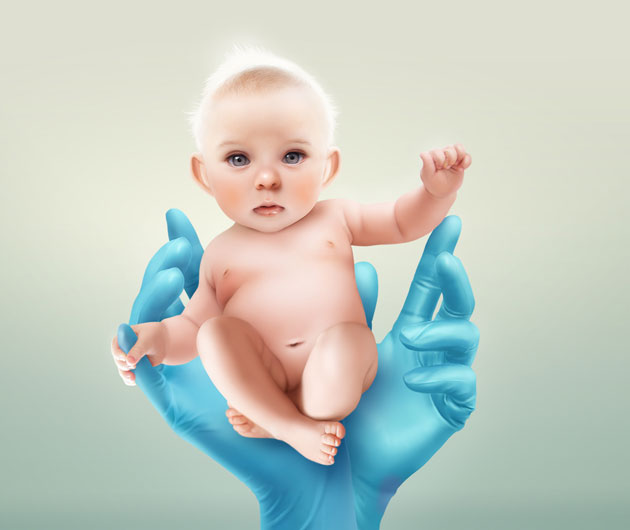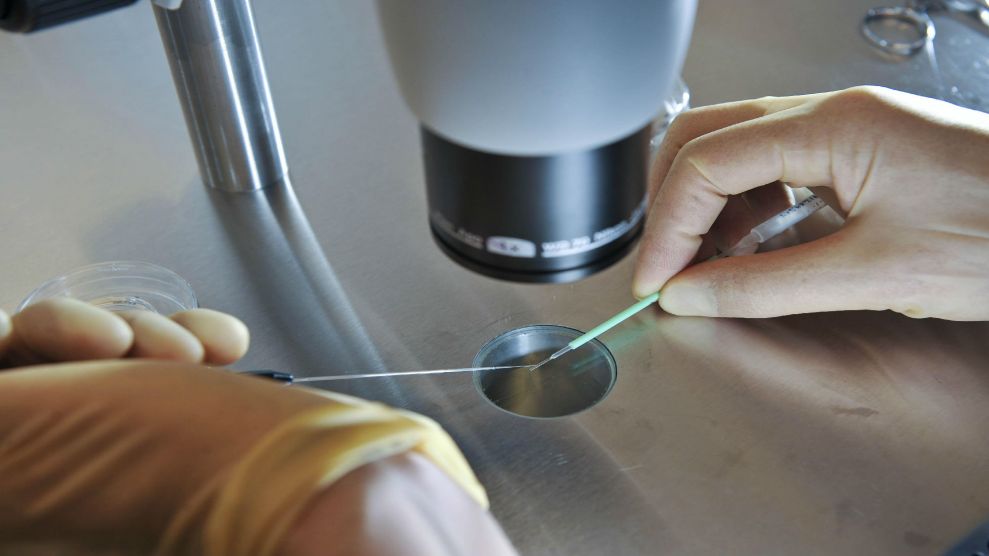
The first step is a no-brainer. Say you are one of the tens of thousands of people with Huntington’s disease, a terrible, hereditary neurodegenerative disorder caused by a mutation in the HTT gene. The diseased version of the gene makes an abnormally long protein that becomes toxic in your neurons, eventually killing them. Symptoms usually appear in your 30s or 40s as small twitching movements, a lack of coordination, and depression. In the coming years, the spasms will grow. It will be increasingly difficult to walk, talk, and think. Within 20 years, you will most likely be dead. You are resigned to your fate, but you and your partner would very much like to have kids, and you have no interest in passing this particular legacy to your child.
Today, your best bet is a procedure called preimplantation genetic diagnosis (PGD), in which embryos produced through in vitro fertilization (IVF) are screened for the unwanted gene. PGD has been a game changer for many couples, but it has limitations. You may be one of the unlucky few who has two copies of the bad HTT, in which case all your embryos are guaranteed to inherit one copy. Or you could be uncomfortable with the idea of producing and discarding multiple embryos.
Soon you may have another option. The invention of CRISPR—a tool that allows scientists to program a protein to change specific sequences of DNA within a cell—gives us the ability to edit the human genome. We could change the bad code in the HTT gene of an embryo back to a normal version. We could even fix the code in your sperm or eggs before conception, ensuring an embryo that’s free of Huntington’s.
And it’s not just Huntington’s. As much as 10 percent of the population carries genes that put them at risk for disorders such as sickle-cell anemia, Tay-Sachs, cystic fibrosis, ataxia, muscular dystrophy, hemophilia, and albinism. These diseases originally arose as random mutations in the distant past, but they have been stalking families ever since, passed from generation to generation. Genetic editing promises the ability to fix your germline—and stop that tragic legacy in its tracks.
Since the development of CRISPR several years ago, people have speculated on its potential to free humanity from painful diseases and worried about the creepy places it could take us. But it seemed as if we had years to weigh the consequences. Then, in March, a Chinese team announced they had successfully fixed disease-causing genes in viable human embryos, including one for favism, a disease that triggers anemia. CRISPR still wasn’t ready for prime time—it fixed some of the cells in the embryos, but not all of them, and it also caused some “off target” mutations in other genes—but then in July, researchers at Oregon Health and Science University reportedly fixed genetic diseases in dozens of viable embryos without any unintended effects. Suddenly, human gene editing was real.
While CRISPR is powerful, it’s not perfect. The technology can go awry—by, say, making mutations in other genes. And there are moral issues. “Sometimes I feel like we’re not on a slippery slope—we’re flying off a cliff,” Marcy Darnovsky, executive director of the Center for Genetics and Society, which opposes the use of human germline modification for any purpose, told me recently. “People used to see this as a speculative science-fiction future, and now it’s an urgent social-justice challenge.”
Cue Gattaca, the 1997 film about a dystopian society in which people are genetically engineered and “natural” children are considered inferior. Darnovsky’s fear is that once we alter genes that cause disease, we’ll alter other genes, too. And who’s to say what’s a disease and what isn’t? “Once we start down that line, we’re accepting a story that tells us that some people are genetically superior to other people,” she told me. “We’d be in a world of genetic haves and have-nots. Parents who have the money will feel like they need to keep up. Fertility clinics will jump right on board.”
When I asked the prominent Stanford bioengineer Drew Endy if he believed we’d soon be designing our heirs, he said, “We already are. It’s happening and everybody’s happy about it.” He pointed out that when he and his wife recently had their second child, they took advantage of a new technique called noninvasive prenatal testing that can sequence part of a fetus’ genome from fragments of fetal DNA circulating in the mother’s blood. “It has become the standard of care at Palo Alto’s children’s hospital. Everybody’s doing it. On the basis of that information, you make a go/no-go decision about carrying to term. This is approximately Gattaca, but we’re not talking about it like that.” It’s become popular so quickly, he says, because it’s less invasive than traditional pregnancy screening techniques.
And since the new test could allow parents to screen for individual genes, over time it could result in certain undesirable genes being eliminated from the gene pool, Endy noted. “That’s shaping the future of the human lineage.”
Does the ability to fix genetic defects in our children force upon us the responsibility to do so? Does it mean that passively allowing nature to take its course is no longer a morally acceptable position? Probably. If I see a child about to get hit by a car, passivity is not an option.
In 2017, after long consideration, the National Academy of Sciences and the National Academy of Medicine issued a controversial 261-page report that paved the way for clinical trials on human germline editing when there was a chance for “preventing a serious disease or condition.” It also recommended that the problematic genes should only be converted to “versions that are prevalent in the population and are known to be associated with ordinary health.” In other words, stick to editing for obvious diseases. Although the report recommended against “using the technology to increase someone’s [ability] to the extreme end of human capacity (or beyond),” it didn’t rule out the possibility of editing for enhancements in the future.
Neither does George Church, the Harvard geneticist who has pioneered much gene-editing research. “If these fixes for severe diseases are shown to be safe and effective,” he told the New York Times, “why would small or large enhancements accompanying the fixes be unacceptable?”
It’s easy to see how today’s enhancements become tomorrow’s standard of care. Sure, we all just want normal kids. But “normal” is a moving target. The Princeton geneticist Lee Silver once envisioned the fertility clinic of the future in a sci-fi story for Time magazine, right down to the ad copy: “Don’t be sorry after she’s born. This really is a once-in-a-lifetime opportunity for your child-to-be.” Silver’s real-life company, GenePeeks, already offers a predictive version of such a service. “GenePeeks Preconception Screen integrates DNA information from two prospective parents, simulating what happens naturally during reproduction. We digitally preview thousands of hypothetical genetic combinations before conception, factoring in known and novel causes of genetic risk.”
In the future, one could imagine prospective parents sitting down with their fertility consultant to decide which genes to change. The BRCA1 gene mutations, made famous by Angelina Jolie, raise a woman’s chance of developing breast cancer during her lifetime from 12 percent to roughly 65 percent. If you inherit two copies of the APOE4 gene variant, your risk of Alzheimer’s increases twelvefold.
Many parents would limit their fixes to obvious diseases. But what’s a disease, and what’s just another way of being human? Scientists are beginning to map specific genetic mutations to human characteristics. Should the GJB2 mutations that result in congenital deafness be corrected? How about the LPHN3 gene variant that is strongly associated with attention deficit hyperactivity disorder ? Or the KLB gene that might affect your desire for alcohol?
One of the most interesting judgment calls might be for the so-called warrior gene, MAOA, which seems to play an important role in aggression. People who have the MAOA-L variant are more likely to commit a violent crime than people who have the “normal” version. The warrior gene is a classic example of the risks of Gattaca-style genetic determinism. Most people with the MAOA-L variant are probably normal citizens—hell, it could even make them great football players or Wall Street traders—but if it’s just a matter of which box to check on my child’s trait list, I’m going with the nonaggro version.
Scientists have already identified a handful of rare gene variants that seem to be upgrades of the standard version most of us possess. A variant of the LRP5 gene results in ultradense, nearly unbreakable bones. People with a variant of the ANGPTL3 gene metabolize triglycerides in their blood so efficiently that they are virtually immune to heart disease. Those possessing the hDEC2 variant need less sleep than normal people, and those with variants of the CCR5 gene don’t get AIDS. Hundreds of other upgrades are likely waiting to be discovered.
Intelligence—the holy grail of germline editing—involves incredibly complex interactions between myriad genes and environmental factors. It can’t be significantly enhanced by simply fiddling with a few genetic dials. Then again, in May researchers announced the identification of 52 genes that may correlate with intelligence, so parents of the future may be able to buy their child a few extra IQ points.
They will certainly be able to buy looks. Features such as a dimpled chin or the way your ear lobes attach are easily determined. The genes responsible for hair, eye, and skin color are fairly clear-cut. If you want a freckle-faced redhead, no problem.
As crazy as this sounds, it’s not hard to envision a future where some version of this is commonplace. The journey from beyond the pale to business as usual is often shorter than we expect. Parents are already choosing the gender of their children as part of their PGD procedures. IVF was considered an abomination by many people when that first test-tube baby came along in 1978. Now it’s routine, if crushingly expensive. Germline editing may well follow the same path.
Do not expect the powers that be to stop our slide down this slope. “No one’s minding the store on this stuff,” Darnovsky told me. Congress passed a law in 2015 forbidding the Food and Drug Administration from reviewing applications for germline editing of human embryos, meaning no clinical trials can move forward. But research continues around the world, and the lack of regulation in some countries means that anyone who wants to escape the rules can do so. Fertility tourism is a major global industry; countries like India, Mexico, and Thailand already offer IVF at a fraction of the US price. China, which produces much of the cutting-edge research in the fertility field, seems to be enthusiastically exploring gene editing. When I told Darnovsky that I often wondered whether a scientist in some little-known lab had already created a genetically engineered child, she said, “I wonder that, too.”
If germline editing doesn’t become commonplace, it may be because of the arrival of another bewildering technology, called in vitro gametogenesis, that will compete with it. Last year, a team of scientists in Japan took the skin cells of mice, transformed those cells into eggs, fertilized them, and implanted the resulting embryos, which resulted in the birth of 26 healthy pups. Some of the pups have now grown up and given birth to families of their own. It shouldn’t be much more difficult to do the same thing with humans.
And if that happens, IVF will be utterly transformed. One major challenge with IVF has always been getting the eggs. The IVF cycle involves 10 days of hormonal injections to stimulate egg growth, the retrieval of mature eggs with a long needle, and other costly and somewhat risky unpleasantries, and it’s limited by the number of eggs that can be retrieved, as well as their quality, which begins to decline after women reach their mid-30s. All that goes away once we are able to make eggs from skin cells. Suddenly, producing hundreds of viable embryos becomes safe, fast, noninvasive, and cost-effective. Older women won’t need egg donors. Neither will men.
The next step will be screening all those embryos. As part of an IVF procedure, thousands of couples already opt for PGD on their handful of embryos. Combine our increasing ability to read genes with the potential of unlimited eggs, and you get what Stanford bioethicist Henry Greely calls Easy PGD. In his book, The End of Sex, Greely argues that within a few decades, most people in the developed world will reproduce with Easy PGD. A fertility clinic will create 100 embryos for you and sequence the genome of each. You and your partner will then go through the analysis of each potential child, weighing the pros and cons of the musical prodigy with the raised risk of schizophrenia versus the redhead with the strong athletic ability, and decide which of the 100 options to bring into the world.
As with germline editing, nothing is likely to stop this. The basic research is either already in place or underway, in part because most of it has additional medical applications. There will be huge sums of money to be made. At the same time, governments and insurers will embrace Easy PGD because it will save so much in costs by increasing the odds of people being born healthy and able-bodied. Same-sex couples could be among the first to champion the technology, because sperm could be made as easily as eggs from the stem cells of any gender, allowing any two individuals to have biological children. Some people will object to the discarding of so many embryos on religious or ethical grounds, but many will not.
There will also, of course, be huge quandaries about how Easy PGD could change our understanding of parenthood, families, diversity, and fairness. Will a society that can pick its offspring converge on a sort of Ivy League blandness? Or will daring parents opt for the shar-peis in their prospective litters? What will become of the human race if variance is smoothed out? Perhaps most important, will everyone have access to this technology, or only the well-off? Greely believes Easy PGD will be far cheaper than IVF is today, and likely more of an equalizer than a divider. But at least in the short term, germline editing and Easy PGD may well accentuate the differences in health between rich and poor populations that are already too obvious today.
Not long ago, I stood in a Cambridge, Massachusetts, office building on the banks of the Charles River, minutes from Harvard and MIT, and watched a printer spit tiny drops of liquid onto a slide. Instead of ink, each of its nozzles shot one of the four nucleotides that create DNA—the As, Cs, Gs, and Ts. The nozzles flew over the glass, with each drop adding a nucleotide—a single letter—to one of thousands of infinitesimal stacks on the one-by-three-inch slide, where they bound in place. The machine was printing DNA.
Humans first learned how to synthesize DNA decades ago, but until recently the technique was so expensive that it was fairly useless outside the lab. But thanks to breakthroughs, the cost of printing a base pair of genes has plunged from $600 in 1980 to a fraction of a cent and is continuing to drop. This is where new genes now originate. When a genetic engineer needs a human gene for cancer therapy, she no longer needs a Henrietta Lacks to source the gene; she just looks up the sequence for that gene and emails it to a DNA synthesis company. A few days later, the gene arrives in the mail.
Each of us has billions of letters of genetic code. We can’t yet synthesize DNA strands nearly that long—it’s complicated to print more than about 10,000 letters—but last year George Church and other scientists held a summit down the street that explored that possibility. In the meeting, some of the world’s top biotechnologists discussed a new 10-year undertaking called Human Genome Project-write, or HGP-write. While the original Human Genome Project (HGP-read), which was completed in 2003, sought to sequence (read) the full human genome, part of HGP-write’s goal is to build a complete human genome. In theory, that DNA could be inserted into a cell nucleus and grown into a human being.
Participants in the conference were asked not to speak to the media, but an open letter by Drew Endy, who refused to attend, drew attention to it. Endy has long been one of the leading proponents of genetic engineering, but for him, the meeting crossed a line. “The possibility of making a human cell, whose genome is realized from only digital information and raw materials, should trigger broader considerations,” he and his co-author, the bioethicist Laurie Zoloth, wrote. “Given that human genome synthesis is a technology that could be used to completely redefine the core of what now joins all of humanity together as a species, we argue that discussions of making such capacities real, like today’s Harvard conference, should not take place without open and advance consideration of whether it is morally right to proceed.”
After Endy’s letter, a firestorm of press consumed the project leaders, who protested that making a synthetic human was never the goal. They changed the name to GP-write and said they would tackle multiple large genomes, including those of humans, but the goal was simply to master genetic code. The team addressed many of Endy’s points in the FAQ section of their website (“Does this project propose the creation of so-called ‘parentless babies’?” “Do you agree with the statement made in the media: ‘Such an enormous moral gesture should not be discussed behind closed doors’?”), and they ensured that their second conference, a two-day affair in New York in May, was as open as a Unitarian service. Everyone was welcome, the keynote was livestreamed, and the panels were crawling with bioethicists. The optics had changed, but the research was moving forward as quickly as before.
Endy’s letter earned him a reputation as the cautious guy in the synthetic biology community, but he’s not. When a panel of four experts, including Endy and Church, was asked at the 2016 World Science Festival in New York who would be in favor of synthesizing a human genome, Endy’s hand shot up first (followed quickly by the rest). He can’t imagine that we’d invent one of the most potentially beneficial technologies of all time and not use it. “As living matter becomes engineerable, some things actually should change,” he stressed to me. “Having these capacities emerge changes our understanding and appreciation of who we are and how we interact with everything else that’s alive.”
At the same time, he knows that most of us have not been grappling with these issues for years. That’s why he’d like to move everything into the open and have the crazy conversations now, so the weirdness doesn’t catch us by surprise. On the 2015 final exam for his Introduction to Bioengineering course at Stanford, Endy pointed out that the cost of synthesizing genes had dropped to 4 cents per pair of DNA letters and was continuing to halve every two years, while tuition at Stanford cost about $47,000 a year and had doubled over the past 15 years. Students were asked to calculate when the cost of a synthesized human genome and a year at Stanford would intersect. (Answer: 2036.) Endy then asked, “As potential parents, would you prefer to spend your savings on college tuition for a natural child or on realizing a genetically engineered offspring?” The question split the class.
But will they still be split in 10 years? They’ll undoubtedly have a very different attitude toward the question than my generation did, since we won’t be forced to make such decisions. We’ll have passed down our genes the old-fashioned way. But our kids may well decide that what we gave them isn’t good enough.












